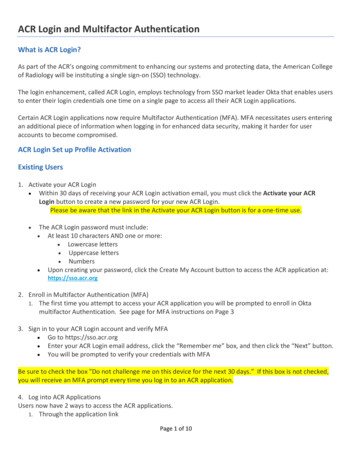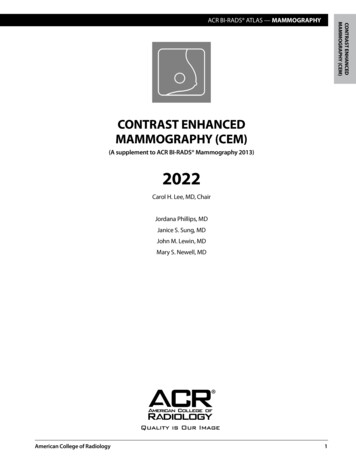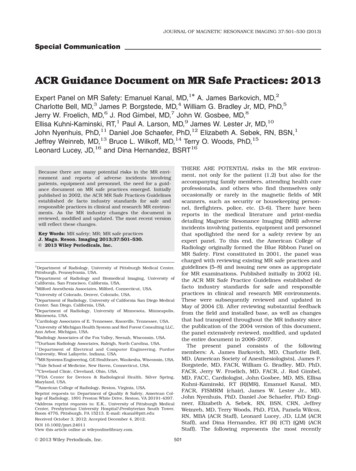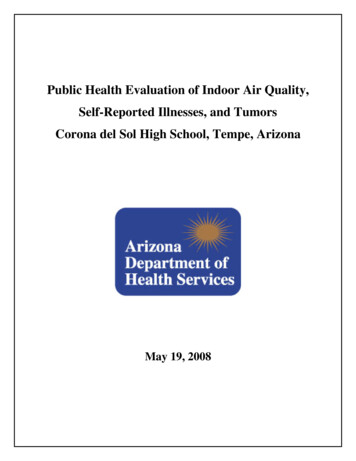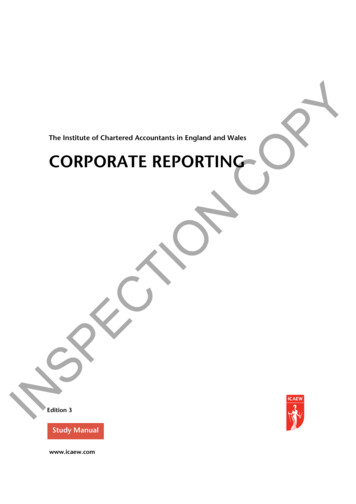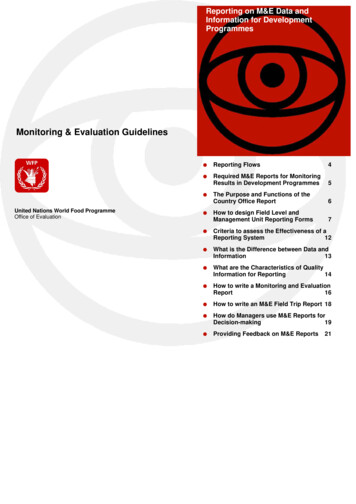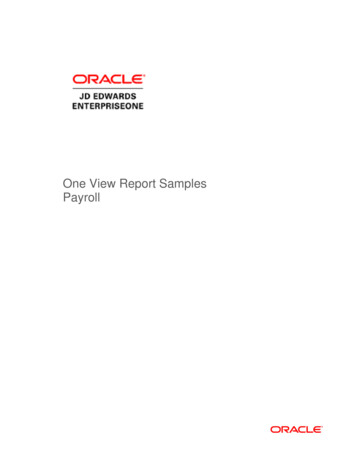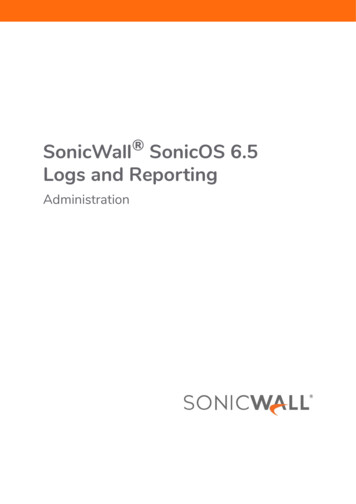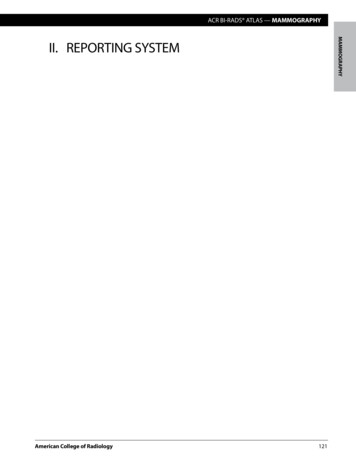
Transcription
ACR BI-RADS ATLAS — MAMMOGRAPHYMAMMOGRAPHYII. REPORTING SYSTEMAmerican College of Radiology121
MAMMOGRAPHY2013122American College of Radiology
ACR BI-RADS ATLAS — MAMMOGRAPHYMAMMOGRAPHYA. REPORT ORGANIZATION (Guidance chapter, see page 147)The reporting system should be concise and organized using the following structure. A statementindicating that the current examination has been compared to previous examination(s) should beincluded (specify date[s]). If this is not included, it should be assumed that no comparison has beenmade, although it is preferable to indicate that no comparison was made.Table 4. Report OrganizationReport Structure1. Indication for examination2. Succinct description of the overall breast composition3. Clear description of any important findings4. Comparison to previous examination(s), if deemed appropriate by the interpreting physician5. Assessment6. Management1. INDICATION FOR EXAMINATIONProvide a brief description of the indication for examination. This may be screening for anasymptomatic woman, recall of a screening-detected finding, evaluation of a clinical finding(specify the finding and its location), or follow-up of either a probably benign lesion or cancertreated with breast conservation. If an implant is present, both standard and implant-displacedviews should be performed, and this should be stated in the mammography report.2. SUCCINCT DESCRIPTION OF THE OVERALL BREAST COMPOSITIONThis is an overall assessment of the volume of attenuating tissues in the breast, to help indicate the relative possibility that a lesion could be obscured by normal tissue and that thesensitivity of examination thereby may be compromised by dense breast tissue. A few coalescent areas of dense tissue may be present in breasts with as little as 10% dense tissue,whereas primarily fatty areas may be present in breasts with as much as 90% dense tissue.Since mammography does not depict all breast cancers, clinical breast examination is acomplementary element of screening. Findings at clinical breast examination should not beignored and may have increased importance in the dense breast.The available data do not support the use of mammographic breast density for determiningscreening frequency.The following four categories of breast composition are defined by the visually estimated content of fibroglandular-density tissue within the breasts. Please note that the categories are listedas a, b, c, and d so as not to be confused with the numbered BI-RADS assessment categories.If the breasts are not of apparently equal density, the denser breast should be used to categorize breast density. The sensitivity of mammography for noncalcified lesions decreases as theBI-RADS breast density category increases. The denser the breast, the larger the lesion(s) thatmay be obscured. There is considerable intra- and inter-observer variation in visually estimating breast density between any two adjacent density categories. Furthermore, there is onlyAmerican College of Radiology123
MAMMOGRAPHY2013a minimal and insignificant difference in the sensitivity of mammography between the densestbreast in a lower-density category and the least dense breast in the next-higher-density category.These factors limit the clinical relevance of breast density categorization for the individual woman.Table 5. Breast TissueBreast Composition Categoriesa. The breasts are almost entirely fattyb. There are scattered areas of fibroglandular densityc. The breasts are heterogeneously dense, which may obscure small massesd. The breasts are extremely dense, which lowers the sensitivity of mammographya. The breasts are almost entirely fatty.Unless an area containing cancer is not included in the image field of the mammogram,mammography is highly sensitive in this setting.b. There are scattered areas of fibroglandular density (historically, there are scattered fibroglandular densities).It may be helpful to distinguish breasts in which there are a few scattered areas of fibroglandular-density tissue from those in which there are moderate scattered areas of fibroglandular-density tissue. Note that there has been a subtle change in the wording of this category,to conform to BI-RADS lexicon use of the term “density” to describe the degree of x-rayattenuation of breast tissue but not to represent discrete mammographic findings.c. The breasts are heterogeneously dense, which may obscure small masses.It is not uncommon for some areas in such breasts to be relatively dense while other areasare primarily fatty. When this occurs, it may be helpful to describe the location(s) of thedenser tissue in a second sentence, so that the referring clinician is aware that these arethe areas in which small noncalcified lesions may be obscured. Suggested wordings for thesecond sentence include:“The dense tissue is located anteriorly in both breasts, and the posterior portions are mostlyfatty.”“Primarily dense tissue is located in the upper outer quadrants of both breasts; scatteredareas of fibroglandular tissue are present in the remainder of the breasts.”d. The breasts are extremely dense, which lowers the sensitivity of mammo graphy.The sensitivity of mammography is lowest in this density category.The fourth edition of BI-RADS , unlike previous editions, indicated quartile ranges of percentage dense tissue (increments of 25% density) for each of the four density categories,with the expectation that the assignment of breast density would be distributed moreevenly across categories than the historical distribution of 10% fatty, 40% scattered, 40%heterogeneously, and 10% extremely dense. However, it has since been demonstrated in124American College of Radiology
ACR BI-RADS ATLAS — MAMMOGRAPHYMAMMOGRAPHYclinical practice that there has been essentially no change in this historical distribution acrossdensity categories, despite the 2003 guidance provided in the BI-RADS Atlas (Figure 149).Figure 149 – U.S. Radiologists’ Use of BI-RADS Breast Density Descriptors, 71998Fatty199920002001Scattered areas200220032004Heterogeneously dense2005200620072008Extremely denseData from 3,865,070 screening mammography examinations interpreted by radiologists who participate in the Breast Cancer Surveillance Consortium (BCSC),a group of seven population-based mammography registries covering geographically, ethnically, and socioeconomically diverse areas of the United States.Data collection for this work was supported by the National Cancer Institutefunded BCSC cooperative agreement (U01CA63740, U01CA86076, U01CA86082,U01CA63736, U01CA70013, U01CA69976, U01CA63731, U01CA70040). Wethank the BCSC investigators, participating women, mammography facilities,and radiologists for the data they have provided for this study. A list of the BCSCinvestigators and procedures for requesting BCSC data for research purposes areprovided at: http://breastscreening.cancer.gov/.American College of Radiology125
MAMMOGRAPHY2013The absence of change in clinical practice of the assignment of breast density across categoriesmay reflect the reality that a few coalescent areas of dense tissue may be present in breasts withas little as 10% dense tissue, whereas primarily fatty areas may be present in breasts with as muchas 90% dense tissue.The fifth edition of BI-RADS no longer indicates ranges of percentage dense tissue for the fourdensity categories. This is done to emphasize the text descriptions of breast density, which reflectthe masking effect of dense fibroglandular tissue on mammographic depiction of noncalcifiedlesions, because the Committee on BI-RADS concludes that the association of subjectively estimated breast density with changes in the sensitivity of mammography is clinically more important than the relatively smaller effect of percentage breast density as an indicator for breastcancer risk.The Committee on BI-RADS indeed is aware of recent and continuing investigations of percentage breast density as an indicator for breast cancer risk, and by eliminating percentage ranges wedo not intend to compromise or impede any such research. We simply recognize the reality thatinterpreting physicians will continue to use density categories in mammography reports as theyhave done over the past many years, independent of BI-RADS guidance on percentage breastdensity. We further recognize that both subjective estimates and planimetry measurements ofbreast density based on area as depicted on (2-D) mammograms are imprecise indicators ofthe volume of dense tissue, which may be measured using (3-D) cross-sectional breast imagingmodalities.1 We await publication of robust volume-based breast density data, using validatedpercentage cut points (not necessarily quartiles) that are readily and reproducibly determinedat imaging, before again indicating percentage ranges for BI-RADS density categories. We alsourge avoidance of numbers to classify breast density instead of BI-RADS terminology in orderto avoid confusion with BI-RADS assessment categories, which are numbered.Some breasts may appear more or less dense when imaged using full-field digital mammography compared to screen-film mammography. Superior depiction of the skin line by digitalmammography provides the observer with a more accurate (and usually larger) estimate ofthe extent of the subcutaneous fat. However, no change in the distribution across density categories has been observed when comparing full-field digital mammography with screen-filmmammography.2126American College of Radiology
ACR BI-RADS ATLAS — MAMMOGRAPHYMAMMOGRAPHYBREAST COMPOSITION ILLUSTRATIONSAmerican College of Radiology127
MAMMOGRAPHY2013BREAST COMPOSITION ILLUSTRATIONSa. The breasts are almost entirely fatty.Figure 150 — The breasts are almost entirely fatty.128American College of Radiology
ACR BI-RADS ATLAS — MAMMOGRAPHYMAMMOGRAPHYBREAST COMPOSITION ILLUSTRATIONSb. There are scattered areas of fibroglandular density.Figure 151— There are scattered areas of fibroglandular density.American College of Radiology129
MAMMOGRAPHY2013BREAST COMPOSITION ILLUSTRATIONSc. The breasts are heterogeneously dense, which may obscure small masses.Figure 152 — The breasts are heterogeneously dense, which may obscure small masses.130American College of Radiology
ACR BI-RADS ATLAS — MAMMOGRAPHYMAMMOGRAPHYFigure 153 — Breast density is classified using the denser breast. In this case, because the fibroglandular tissue in the upper outer right breast is sufficiently dense to obscure small masses, theexamination should be classified as HETEROGENEOUSLY DENSE, even though far less than 50% ofthe volume of this (denser) breast contains fibroglandular-density tissue.American College of Radiology131
MAMMOGRAPHY2013BREAST COMPOSITION ILLUSTRATIONSd. The breasts are extremely dense, which lowers the sensitivity of mammography.Figure 154 — The breasts are extremely dense, which lowers the sensitivityof mammography.132American College of Radiology
ACR BI-RADS ATLAS — MAMMOGRAPHYMAMMOGRAPHY3. CLEAR DESCRIPTION OF ANY IMPORTANT FINDINGS(It is assumed that most important findings are either of concern at screening, inherently suspicious, new, or seen to be larger/more extensive when compared to previous examination.)a. Mass:SizeMorphology (shape, margin)DensityAssociated calcificationsAssociated featuresLocationb. Calcifications:Morphology — describe typically benign type or describe shape of particlesDistribution (may not be appropriate for typically benign calcifications)Associated featuresLocationc.Architectural Distortion:Associated calcificationsAssociated featuresLocationd. Asymmetries (asymmetry, global asymmetry, focal asymmetry, developing asymmetry):Associated calcificationsAssociated featuresLocatione. Intramammary lymph node (rarely important):Locationf.Skin lesion (rarely important):Locationg. Solitary dilated duct (rarely present):LocationAmerican College of Radiology133
MAMMOGRAPHY20134. COMPARISON TO PREVIOUS EXAMINATION(S), IF DEEMED APPROPRIATE BY THE INTERPRETINGPHYSICIANComparison to previous examination may assume importance if the finding of concern requiresan evaluation of change or stability. Comparison is not important when a finding has unequivocally benign features. Comparison may be irrelevant when the finding is inherently suspiciousfor malignancy.5. ASSESSMENTThe incorporation of an assessment category in the overall summary of the mammography reportis mandated by the Food and Drug Administration, Quality Mammography Standards; Final Rule.3Whereas FDA-mandated assessments are not linked to management recommendations, BI-RADS assessment categories are designed to be concordant with specific management recommendations. The linking of assessment categories with concordant management recommendationsfurther enhances sound medical practice.All final assessments (BI-RADS categories 1, 2, 3, 4, 5, and 6) should be based on thoroughevaluation of the mammographic features of concern or after determination that an examination is negative or benign.An incomplete (category 0) assessment is usually given for screening examinations when additional imaging evaluation is recommended before it is appropriate to render a final assessment. There may be rare situations in the screening setting in which a category 4 or 5 assessment is used, but this practice is discouraged because it may compromise some aspects ofoutcome analysis.A recall (category 0) assessment should include specific suggestions for the next course of action(spot-compression magnification views, US, etc.).6. MANAGEMENTIf a suspicious abnormality is identified, the report should indicate that a biopsy should be performed in the absence of clinical contraindication. This is an assessment for which the interpreting physician has sufficient concern that biopsy is warranted based on imaging findings. Therecommended language (“biopsy should be performed in the absence of clinical contraindication”) provides for the unusual circumstance in which either the patient or her physician mightreasonably wish to defer a biopsy.Interpretation is facilitated by recognizing that most examinations may be categorized under a fewheadings. These are listed in Table 6 and numeric codes are included for computer use.134American College of Radiology
ACR BI-RADS ATLAS — MAMMOGRAPHYMAMMOGRAPHYB. ASSESSMENT CATEGORIESTable 6. Concordance Between BI-RADS Assessment Categories and Management RecommendationsAssessmentManagementLikelihood of CancerCategory 0: Incomplete – NeedRecall for additionalN/AAdditional Imaging Evaluation and/or imaging and/or comparisonPrior Mammograms for Comparisonwith prior examination(s)Category 1: NegativeRoutine mammographyscreeningEssentially 0% likelihood of malignancyCategory 2: BenignRoutine mammographyscreeningEssentially 0% likelihood of malignancyCategory 3: Probably BenignShort-interval (6-month) 0% but 2% likelihood of malignancyfollow-up or continuedsurveillance mammography(Figure 155, see page 152)Category 4: SuspiciousCategory 4A: Low suspicion formalignancyTissue diagnosis 2% but 95% likelihood of malignancy 2% to 10% likelihood of malignancyCategory 4B: Moderate suspicion formalignancy 10% to 50% likelihood ofmalignancyCategory 4C: High suspicion formalignancy 50% to 95% likelihood ofmalignancyCategory 5: Highly Suggestive ofMalignancyTissue diagnosis 95% likelihood of malignancyCategory 6: Known Biopsy-ProvenMalignancySurgical excision whenclinically appropriateN/Aa. Mammographic Assessment Is IncompleteCategory 0: Incomplete — Need Additional Imaging Evaluation and/or Prior Mammogramsfor ComparisonFor this assessment category, the text may be shortened to “Incomplete — Need Additional Imaging Evaluation” or “Incomplete — Need Prior Mammograms for Comparison”, as appropriate. Referto Table 9 (see page 168) in Frequently Asked Question #1 in the Guidance chapter for a listing ofFDA-approved equivalent wording for assessment categories.There is a finding for which additional imaging evaluation is needed. This is almost always used in ascreening situation. Under certain circumstances this assessment category may be used in a diagnostic mammography report, such as when US equipment or personnel are not immediately available,or when the patient is unable or unwilling to wait for completion of a full diagnostic examination. Arecommendation for additional imaging evaluation includes the use of spot-compression (with orwithout magnification), special mammographic views, and US. Category 0 should not be used fordiagnostic breast imaging findings that warrant further evaluation with MRI. Rather, the interpretingphysician should issue a final assessment in a report that is made before the MRI examination is performed. Refer to Frequently Asked Question #8 (See page 162) in the Guidance chapter for furtherdiscussion.American College of Radiology135
MAMMOGRAPHY2013In most circumstances and when feasible, if a mammography examination is not assessed asnegative or benign, the current examination should be compared with prior examination(s). Theinterpreting physician should use judgment on how vigorously to attempt obtaining prior examinations, given the likelihood of success of such an endeavor and the likelihood that comparisonwill affect the final assessment. In this context, it is important to note that comparison with previous examination(s) may be irrelevant when a finding is inherently suspicious for malignancy.Category 0 should be used for prior image comparison only when such comparison is required tomake a final assessment. When category 0 is used in the context of awaiting prior examinationsfor comparison, there should be in place a tracking procedure guaranteeing with 100% reliabilitythat a final assessment will be made within 30 days (preferably sooner) even if prior examinationsdo not become available. Some mammography practices may reasonably choose never to usecategory 0 in the context of awaiting prior examinations simply because they do not have a 100%reliable tracking procedure. If a mammography examination is assessed as category 0 in the context of awaiting prior examinations and then the prior examinations do become available, an addendum to the initial mammography report should be issued, including a revised assessment. Forauditing purposes, the revised assessment should replace the initial assessment (see the Followup and Outcome Monitoring section).b. Mammographic Assessment Is Complete — Final Assessment CategoriesCategory 1: Negative (see Guidance chapter)There is nothing to comment on. This is a normal examination.Category 2: Benign (see Guidance chapter)Like category 1, this is a normal assessment, but here the interpreter chooses to describe a benign finding in the mammography report. Involuting calcified fibroadenomas, skin calcifications,metallic foreign bodies (such as core biopsy and surgical clips), and fat-containing lesions (suchas oil cysts, lipomas, galactoceles, and mixed-density hamartomas) all have characteristically benign appearances and may be described with confidence. The interpreter may also choose todescribe intramammary lymph nodes, vascular calcification, implants, or architectural distortionclearly related to prior surgery while still concluding that there is no mammographic evidenceof malignancy. On the other hand, the interpreter may choose not to describe such findings, inwhich case the examination should be assessed as negative (category 1).Note that both category 1 and category 2 assessments indicate that there is no mammographicevidence of malignancy. Both should be followed by the management recommendation for routine mammography screening. The difference is that category 2 should be used when describingone or more specific benign mammographic findings in the report, whereas category 1 shouldbe used when no such findings are described (even if such findings are present).Category 3: Probably Benign (see Guidance chapter, including Figure 155)136A finding assessed using this category should have a 2% likelihood of malignancy, but greaterthan the essentially 0% likelihood of malignancy of a characteristically benign finding. A probably benign finding is not expected to change over the suggested period of imaging surveillance, but the interpreting physician prefers to establish stability of the finding before recommending management limited to routine mammography screening.American College of Radiology
ACR BI-RADS ATLAS — MAMMOGRAPHYThere are several prospective clinical studies demonstrating the safety and efficacy of periodicmammographic surveillance instead of biopsy for specific mammographic findings.4–9 Threespecific findings are validated as being probably benign (noncalcified circumscribed solid mass,focal asymmetry, and solitary group of punctate calcifications). All the previously cited studiesemphasize the need to conduct a complete diagnostic imaging evaluation before making aprobably benign (category 3) assessment; hence, it is recommended not to render such an assessment in interpreting a screening mammography examination. The practice of renderingcategory 3 assessments directly from screening examination also has been shown to result inadverse outcomes: 1) unnecessary follow-up of many lesions that could have been promptlyassessed as benign, and 2) delayed diagnosis of a small number of cancers that otherwise mayhave been smaller in size and less likely to be advanced in stage.10 Also, all the previously citedstudies4–9 exclude palpable lesions, so the use of a probably benign assessment for a palpablelesion is not supported by robust scientific data, although there are two single-institution studiesthat do report successful outcomes for palpable lesions.11,12 Finally, because evidence from previously cited studies indicates the need for biopsy rather than continued surveillance when aprobably benign finding increases in size or extent,4–9 it is not prudent to render a category 3 assessment when a finding that otherwise meets “probably benign” imaging criteria is either newor has increased in size or extent.Refer to Figure 155 (see page 152) at the end of the Guidance chapter for an illustration of the recommended algorithm for follow-up examinations during the entire mammographic surveillanceperiod. While the vast majority of probably benign findings are managed with an initial shortinterval follow-up (6 months) examination followed by additional examinations until long-term(2- or 3-year) stability is demonstrated, there may be occasions in which a biopsy is done instead(patient preference or overriding clinical concern).Category 4: Suspicious (Guidance chapter, see page 153)This category is reserved for findings that do not have the classic appearance of malignancy butare sufficiently suspicious to justify a recommendation for biopsy. The ceiling for category 3assessment is a 2% likelihood of malignancy and the floor for category 5 assessment is 95%,so category 4 assessments cover the wide range of likelihood of malignancy in between. Thus,almost all recommendations for breast interventional procedures will come from assessmentsmade using this category. By subdividing category 4 into 4A, 4B, and 4C, as recommended inGuidance chapter and using the cut points indicated therein, it is hoped that patients and referring clinicians will more readily make informed decisions on the ultimate course of action.Category 5: Highly Suggestive of Malignancy (Guidance chapter, see page 154)These assessments carry a very high probability ( 95%) of malignancy. This category initiallywas established to involve lesions for which 1-stage surgical treatment was considered withoutpreliminary biopsy, in an era when preoperative wire localization was the primary breast interventional procedure. Nowadays, given the widespread acceptance of imaging-guided percutaneous biopsy, 1-stage surgery is rarely, if ever, performed. Rather, current oncologic managementalmost always involves tissue diagnosis of malignancy via percutaneous tissue sampling to facilitate treatment options, such as when sentinel node biopsy is included in surgical managementor when neoadjuvant chemotherapy is administered prior to surgery. Therefore, the current rationale for using a category 5 assessment is to identify lesions for which any non-malignantAmerican College of RadiologyMAMMOGRAPHY137
MAMMOGRAPHY2013percutaneous tissue diagnosis is automatically considered discordant, resulting in the recommendation for repeat (usually surgical) biopsy.138Category 6: Known Biopsy-Proven Malignancy (Guidance chapter, see page 155):This category is reserved for examinations performed after biopsy proof of malignancy (imagingperformed after percutaneous biopsy but prior to complete surgical excision), in which there are nomammographic abnormalities other than the known cancer that might need additional evaluation.American College of Radiology
ACR BI-RADS ATLAS — MAMMOGRAPHYMAMMOGRAPHYC. WORDING THE REPORTThe current examination should be COMPARED TO PRIOR EXAMINATION(S) when appropriate. TheINDICATION FOR EXAMINATION, such as screening or diagnostic, should be stated. The report shouldbe organized with a brief description of the COMPOSITION of the breast and any pertinent FINDINGS,followed by the ASSESSMENT and MANAGEMENT RECOMMENDATIONS. Any verbal discussions between the interpreting physician and the referring clinician or patient should be documented inthe original report or in an addendum to the report.The report should be succinct, using terminology from the latest approved lexicon without embellishment. Definitions of lexicon terms for mammographic findings should not appear in the reportnarrative. Following the impression section and the (concordant) management recommendationsection of the report, both the assessment category number and FDA-approved terminology for theassessment category should be stated. Other aspects of the report should comply with the ACRPractice Guideline for Communication: Diagnostic Radiology.13American College of Radiology139
MAMMOGRAPHY2013REFERENCES1. Kopans DB. Basic physics and doubts about relationship between mammographically determined tissue density and breast cancer risk. Radiology 2008; 246(2):348–353.2. Harvey JA, Gard CC, Miglioretti DL, et al. Reported mammographic density: film-screen versus digital acquisition. Radiology 2013; 266(3):752–758.3. 21CFR Part 16 and 900: Mammography Quality Standards; Final Rule. Federal Register, Washington, DC:Government Printing Office, 62: No. 208; 55851-55994, October 28, 1997.4. Sickles EA. Periodic mammographic follow-up of probably benign lesions: results in 3,184 consecutive cases.Radiology 1991;179(2):463–4685. Varas X, Leborgne F, Leborgne JH. Nonpalpable, probably benign lesions: role of follow-up mammography.Radiology 1992;184(2):409–414.6. Wolfe JN, Buck KA, Salane M, Parekh NJ. Xeroradiography of the breast: overview of 21, 057 consecutive cases.Radiology 1987;165(2):305–311.7. Helvie MA, Pennes DR, Rebner M, Adler DD. Mammographic follow-up of low-suspicion lesions: compliancerate and diagnostic yield. Radiology 1991; 178(1):155–158.8. Vizcaíno I, Gadea L, Andreo L, et al. Short-term follow-up results in 795 nonpalpable probably benign lesionsdetected at screening mammography. Radiology 2001;219(2):475–483.9. Varas X, Leborgne JH, Leborgne F, Mezzera J, Jaumandreu S, Leborgne F. Revisiting the mammographic followup of BI-RADS category 3 lesions. AJR 2002; 179(3):691–695.10. Kerlikowske K, Smith-Bindman R, Abraham LA, et al. Breast cancer yield for screening mammographic examinations with recommendation for short-interval follow-up. Radiology 2005; 234(3):684–692.11. Graf O, Helbich TH, Fuchsjaeger MH, et al. Follow-up of palpable circumscribed noncalcified solid breast massesat mammography and US: can biopsy be averted? Radiology 2004; 233(3):850–856.12. Harvey JA, Nicholson BT, LoRusso AP, Cohen MA, Bovbjerg VE. Short-term follow-up of palpable breast lesionswith benign imaging features: evaluation of 375 lesions in 320 women. AJR 2009; 193(3):1723–1730.13. American College of Radiology. ACR Practice Guideline for Communication: Diagnostic Radiology. http://www.acr.org/ /media/ACR/Documents/PGTS/guidelines/Comm Diag Imaging.pdf. Accessed November 4, 2013.140American College of Radiology
ACR BI-RADS ATLAS — MAMMOGRAPHY American College of Radiology 125 MAMMOGRAPHY Figure 149 - U.S. Radiologists' Use of BI-RADS Breast Density Descriptors, 1996-2008 0 10 1996 20 30 Pe rcentage 40 50 60 70 80 Fatty 90 100 Scattered areas Heterogeneously dense Extremely dense
